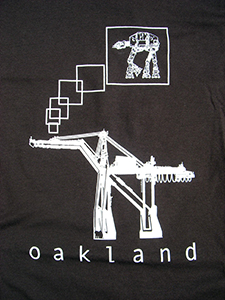Things are looking up in Oakland—all the way up to the top of the port’s 36 container shipping cranes. Port of Oakland cranes, some of them 240 feet tall, have become symbols of a city on the rise.

Photo by Todd Lappin – Flickr Creative Commons
By Patrick Burnson
Published: January, 2015
Things are looking up in Oakland—all the way up to the top of the port’s 36 container shipping cranes. Port of Oakland cranes, some of them 240 feet tall, have become symbols of a city on the rise.
“I think there’s a great sense of pride in Oakland,” said port spokeswoman Marilyn Sandifur. “We’re glad people think our cranes are cool.”
Long the city’s most powerful economic engine, the Port of Oakland has now become the muse of artistic expression, with murals, apparel and storefronts now adopting its cranes as design elements. Here are a few of the places you can find folk art portraying the port’s cranes in Oakland’s business district:
• On the wall outside Oakland Grill, a venerated produce district coffee shop serving truckers, forklift drivers and newly arrived hipsters;
• Cat Town Cafe, the nation’s first coffee house/pet adoption center;
• Screen-printed tote bags and sweatshirts at LuckyLo Art Gallery;
• Beast Oakland, the boutique that has sold 5,000 crane T-shirts; and
• Street art murals.
Bay Crossings readers can see artistic expressions of the Port of Oakland cranes on the YouTube video at this address: http://youtu.be/JPT1yAA5e9c.
Port of Oakland cranes handle 2.3 million shipping containers every year. For a city swelling with new restaurants, new digital-age companies and new spirit, the cranes serve as a reminder that old-school economics centered on trade can still be the foundation for Oakland’s future.
Oakland’s shipping cranes put a local face on international business. Global trade moving through the Port is valued at $40 billion a year, and the port supports 73,000 jobs in the Bay Area. Exporters from as far away as the Central Valley and Reno use Oakland as their gateway to markets in Asia.
“They’re urban, they’re gritty, they’re industrial,” said Loretta Nguyen, owner of LuckyLo at Jack London Square. “People just like them—they say something unique about Oakland.”
There may be another reason, as well. It seems residents generally feel good about the Port of Oakland. In an independent survey of 1,200 Oakland voters last May, 79 percent said that the port is a positive presence in the community. They expressed strong belief that the port generates significant job and economic activity for the region.
Legend holds that Oakland’s cranes inspired the giant, robotic walkers in the Star Wars movies. Revisionist pop culture now credits hydraulic-lift trucks as the model. Regardless, the port’s giant workhorses are inspiring a new era of Oakland pride.
They’re a hit in neighboring Alameda, too. The cranes feature in a Port of Oakland fourth hole at Subpar Miniature Golf.
Bay Area Ports to Participate in Hawaii Conference
When the Association of Pacific Ports (APP) convenes its annual conference in Lihue, Kauai, Hawaii this month, a host of Bay Area members will participate in discussions on environmental stewardship and productivity.
These include the Port of Redwood City, which recently conducted a “working waterfront” tour for its constituents featuring a vessel being loaded with recycled scrap steel at Wharf #3. The Arion SB arrived from South Korea and, after taking possession of 25,000 metric tons of steel, proceeded to the Sims Metal Facility at the Port of Richmond (another APP member) where it took on additional cargo before sailing to Saudi Arabia. The Arion SB is 623 feet long, has a crew of 24, and is flagged in Cyprus.
It should be noted here that the Port of Richmond is northern California’s most diversified cargo handler. With its roots in petroleum and liquid bulk cargos, Richmond has expanded its dry bulk, break-bulk, and containerized cargo handling capabilities and has increased its automobile processing facilities. Today, Richmond ranks number one in liquid bulk and automobile tonnage among ports on San Francisco Bay.
Matson Announces Hawaii Service Rate Increase
As mentioned in last month’s column, APP member Matson, Inc. announced that it is acquiring the stocks of rival carrier, Horizon, and its Alaska operations.
On the heels of that announcement comes news that the Oakland-based carrier will raise rates for its Hawaii service by $225 per westbound container and $110 per eastbound container, effective January 4. The increase will be filed with the Surface Transportation Board. No adjustment will be made to the company’s terminal handling charge. Matson estimates that the rate adjustment will result in shipping costs rising by an average of 5.4 percent.
“This rate increase will help offset rises in operating costs and support ongoing investments in our Hawaii service,” said Dave Hoppes, the company’s senior vice president of ocean services. “The adjustment is consistent with our longstanding philosophy of implementing modest, incremental increases as necessary to maintain the highest levels of service, and is identical to increases implemented in 2012, 2013 and 2014. Matson continues to diligently look for ways to operate the most efficient, cost effective service possible, without undercutting our standards of quality.”
Hoppes further pointed out that in the past decade, Matson has invested nearly $1 billion in four new containerships, fleet enhancements, new container equipment, information technology and upgrades to its terminal facilities. Last year, the company also signed a contract to build two Aloha class 3,600 TEU containerships for its Hawaii service at an aggregate price of $418 million.
Patrick Burnson is the past president and current board member of the Pacific Transportation Association, based in San Francisco. www.pacifictrans.org

